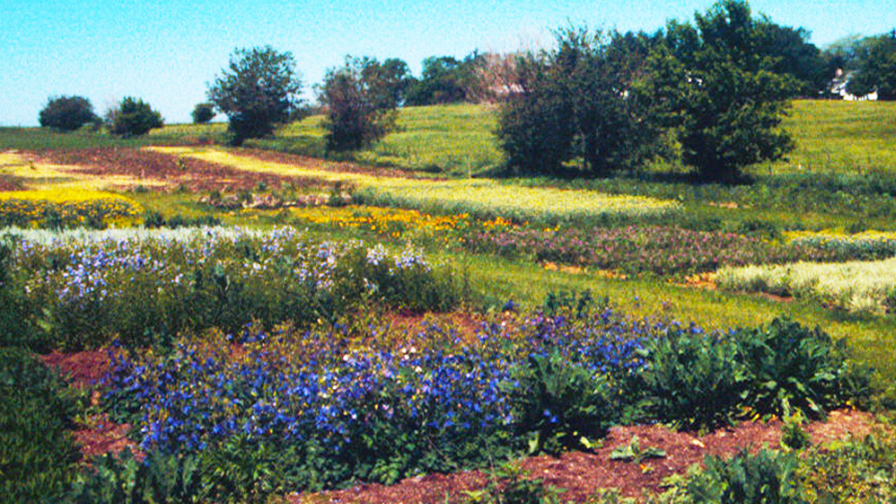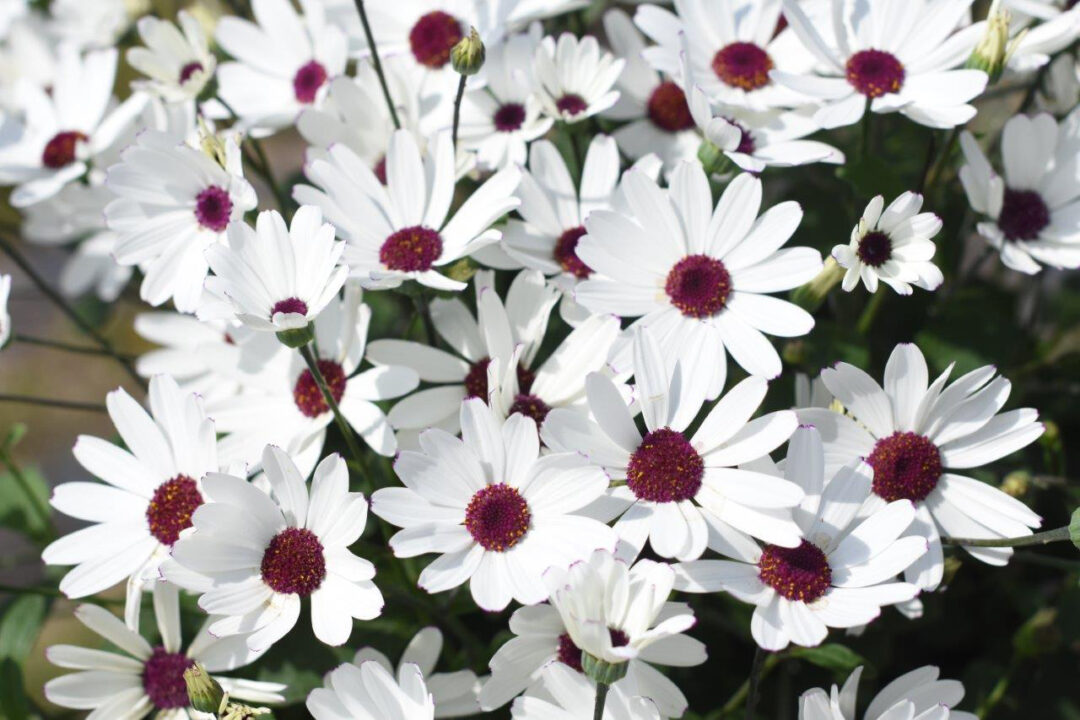Reflections on the 70-Year History of the Midwest Natural Garden

Photo: Midwest Groundcovers
The Midwest Natural Garden is celebrating its 70th year in 2023, continuing a legacy of education and inspiration on native plants. From its inception, The Natural Garden has been a place of passion, learning, and discovery — and has a rich history in the local community and horticultural industry.
The Natural Garden’s story starts in 1953, when Walter Stephens founded the Natural Garden in 1953 after rescuing a variety of native species from development and cultivating woodland natives for his own garden. In 1978, Stephens sold The Natural Garden to Craig Sensor who hired on his first employee of the Natural Garden, Roy Diblik, Northwind Perennial Farm owner and prominent plantsman, horticulturist, and planting design expert.
Former owner Walter Stephens made biweekly visits to the nursery and shared stories and growing expertise with Diblik. A visit to The Morton Arboretum further inspired Sensor and Diblik to grow native prairie plants, and Ray Schulenburg of the Morton Arboretum encouraged and informed their work.
“When I first started in 1978, The Natural Garden was a big weed patch and my job was to pull weeds,” says Diblik. “The sales area was a stump where we kept the change bag. Our biggest sales day was $90, and that first year we made about $1,000. Comparing The Natural Garden back then to today is like comparing the Flintstones to the Jetsons. It was a simple place.”
In the 1980’s, Bob Horlock, avid native plant proponent, ultimately became The Natural Garden’s primary seed supplier by collecting from surrounding natural areas. The Natural Garden Natives collection of plants developed into more than 280 native plant species.
“I learned everything about growing natives from Bob Horlock and Ray Schulenburg,” says Diblik. “These men were driven by passion, and without them, we wouldn’t be where we are today.”
During the 1980’s, The Natural Garden flourished. The nursery specialized in native prairie plant production and was the first nursery in the area to containerize natives. They were considered the expert in growing native prairie plants and also gained recognition for growing perennials. In 1983, the nursery transitioned from field growing to container growing. By the time Diblik left the company in 1991, the company had reached more than $1 million in sales and had become one of the largest perennial retail and wholesale nurseries in Illinois. The Natural Garden had developed a customer base of home gardeners, landscape contractors and architects, conservationists, restorationists, and public entities, such as The Chicago Botanic Garden and The Morton Arboretum.
Janie Grillo, former staff member of The Natural Garden and current employee of Midwest Groundcovers recalls that The Natural Garden drew in customers and fans from all over, not just Chicagoland, but the greater Midwest, including Wisconsin, Iowa, and Indiana. They came for unusual plants that they couldn’t find elsewhere, for natives, definitely, but also for a large and varied selection of herbs.
Grillo says that some customers who came for natives were very knowledgeable and passionate, while some were just learning about their new-found interest. And many were eager to share their new passion. For example, a memorable pair of customers came in one morning.
“Early one Sunday, a couple of motorcycles pulled into the yard. One of the gentlemen said, “I just want to show my buddy that we do really have cactus in Illinois. He doesn’t believe me!”
In 2011, Midwest Groundcovers acquired The Natural Garden, which facilitated a valuable expansion of their native plant lines. Midwest’s management team and The Natural Garden’s staff collaborated for a seamless transition, where Natural Garden employees filled key roles in Midwest’s customer service, marketing, and production team, many of which are still with Midwest. Midwest Groundcovers continues native plant production, but not sales, at The Natural Garden nursery site, now known as Midwest Natural Garden.
Christa Orum-Keller, Chairman and President of Midwest Groundcovers shares, “My personal connection to the value of native plants and their place in our regional ecological heritage, goes back to my childhood and flows through my formal education, including emphasis on native habitat restoration as part of a landscape architect’s framework of site solutions.”
One of the first initiatives was to remove non-natives and plant new native beds, along with removing declining structures and rebuilding and installing new production areas. In 2013, projects were carried out to enhance the production site efficiency, adding a temperature and humidity-controlled seed cooler, additional production growing shelters, and stockbed areas for divisions and seed collection.
Over the years, Midwest Groundcovers has worked to restore and preserve the natural areas, installing gardens for educational use, like the Carex Classroom, and those gardens that are primarily functional, like the bioswale, which catches run-off water, slowing it down and filtering it before it reaches the irrigation pond.
In 2014 and 2015, a new irrigation station and irrigation pond were added. Swales were also installed, planted with plugs, custom mixes that featured more than 35 species. Roy Diblik also planted display beds at Midwest Natural Gardens. Midwest Groundcovers also worked to create educational opportunities for customers, entrance beds, seed collection demo beds.
In 2017, Midwest Natural Garden’s Carex Classroom, which was designed by Trish Beckjord, was developed to display the majority of the native Carex species grown by Midwest Groundcovers and to be used as an educational tool for customers and staff. The Carex species are planted in groups side by side, each group labelled, so that the differences in their appearance and growing habits can be observed. The garden includes woodland and wetland sedges and allows for understanding on how wetland sedges perform when planted outside a wetland environment.
The spring of 2020 was a time of tremendous growth at the Midwest Natural Garden. First, construction of a new building, aptly named The Roy E. Diblik Growing Center, was completed. In addition to offices, a lunchroom, an industrial cooler, and garage space, the growing center also houses the first indoor restrooms in the garden’s 67-year history.
The second exciting addition was the installation of the Midwest Native Display Gardens, designed in collaboration by Austin Eischeid and Jens Jensen. The gardens were designed to showcase native plant compositions that work in different scales, from residential gardens to corporate campuses. Landscape architects and contractors, garden centers, and native plant enthusiasts tour the gardens frequently for inspiration and to learn about natives.
The natives grown at this location are now sold through Midwest Groundcovers under the Natural Garden Natives brand. This proprietary brand has more than 200 species of native forbs, grasses, and shrubs, which are local eco-type within 90 miles of St. Charles, IL, and are all neonicotinoid-free. They are sold with branded pots and tags, to help consumers identify the Natural Garden Natives brand at retail. Enrique Rodriguez is the Production Foreman at Natural Garden Natives, and has been with Midwest since 1999, and has worked to build and maintain the native lines. Enrique has a breadth of horticultural experience and knowledge, and has taken classes with well-known botanist Gerould Wilhelm (Author of The Origin of Flora of the Chicago Region).
Today, the Midwest Natural Garden spans 29 acres, housing growing shelters, gardens, and stock beds. From production of native plants to educational display gardens, the Midwest Natural Garden continues to be a place of learning and inspiration for Midwest Groundcovers’ employees, customers, and native enthusiasts, with a rich history and 70-year legacy in the horticulture industry.
Midwest Natural Garden’s legacy and future has much personal meaning to Orum-Keller.
“While in college, I had the privilege of interning at The Natural Garden and first meeting Roy during that time,” she says. “It is a great reward to have been able to support the legacy that Mr. Stephens started, and so many others stewarded along the way. It’s a joy to see our industry thrive and greatly expand our use of native plants and I look forward to continuing to strongly support those trends.”
Midwest Groundcovers will be hosting an open house at the Midwest Natural Garden on September 29, 2023, for horticulture industry professionals. Attendees will have the opportunity to tour the display gardens, the Carex Classroom, and the production areas. More information about the open house can be found at www.midwestgroundcovers.com/blog/mngopenhouse.com.









